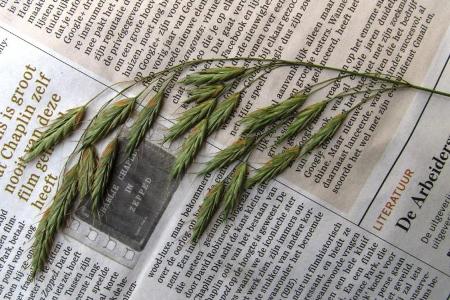Bromus japonicus Thunb. (syn.: B. patulus Mert. et W.D.J. Koch) (SE-Eur., SW-As.) – A more or less frequent but always ephemeral alien. Probably first collected in 1862 in Aalst. Formerly chiefly introduced with wool, nowadays usually associated with grain importation. Seen most years in port areas, near granaries, under grain conveyors, along road verges and railway tracks or on dumps, sometimes in abundance.
This species is much confused with Bromus arvensis in Belgian herbaria (see also Oja & Paal 2007), especially before the curving-out of the lemma awns (typical of Bromus japonicus s.str. but occasionally seen in B. arvensis as well and absent in B. japonicus subsp. subsquarrosus (Borbás) Pénzes; see below). Both are however easily distinguished: Bromus japonicus has small anthers 0,2-1,8 mm long (much shorter than the lemma) whereas in B. arvensis anthers are 3,5-5 mm long, ca. half as long as the lemma. Moreover, in the latter the palea nearly equals the lemma whereas in Bromus japonicus the palea is distinctly shorter than the lemma. Finally, leaf sheath pubescence is also rather different in both species: in Bromus arvensis the lowermost leaf sheaths are shortly, appressed pubescent (with most hairs ca. 0,4-0,6 mm long and more or less retrorse) while B. japonicus has leaf sheaths with longer, patent hairs. As a matter of fact confusion between Bromus japonicus and B. squarrosus is more likely. Both have curved out awns and a diffuse inflorescence with long-pedicelled spikelets in common (for differences see under the latter).
Bromus japonicus itself is a variable species. Several infraspecific taxa have been distinguished. Out of these, subsp. subsquarrosus (syn.: var. transsilvanicus Auerswald) was recorded as a grain alien in the port of Gent in 2009. Its awns are straight and its spikelets narrower (see also Scholz 2002, Portal 2004, Scholz 2008). Confusion is furthermore likely with the Australian Bromus arenarius and B. pectinatus (and related species) from Africa and Asia. The former was formerly recorded as a very rare wool alien and new records are not to be expected (although it is locally naturalised in North America as well; see Pavlick & Anderton 2007). It has conspicuously sinuous, nearly capillary panicle branches. Bromus pectinatus and its relatives may well be overlooked (see Scholz 1981 for an overview). These species have narrower lemmas that are papery in texture and with prominent ribs. Their exact placement is somewhat critical: all share characters of sections Bromus and Genea.
 |
 |
 |
 |
 |
 |
Selected literature:
Oja T., Jaaska V. & Vislap V. (2003) Breeding system, evolution and taxonomy of Bromus arvensis, B. japonicus and B. squarrosus (Poaceae). Plant Syst. Evol. 242: 101-117.
Oja T. & Paal J. (2007) Multivariate analysis of morphological variation among closely related species Bromus japonicus, B. squarrosus and B. arvensis (Poaceae) in comparison with isozyme evidences. Nordic J. Bot. 24(6): 691-702.
Pavlick L.E. & Anderton L.K. (2007) Bromus. In: Barkworth M.E. & al. (eds.), Flora of North America north of Mexico, vol. 24: 193-237. Oxford University Press, New York-Oxford.
Portal R. (2004) Quelques Bromus sur la Sellette. Bull. Assoc. Bot. Digitalis 3: 18-30.
Scholz H. (1981) Der Bromus pectinatus-Komplex (Gramineae) im Nahen und Mittleren Osten. Bot. Jahrb. Syst. 102: 471-495.
Scholz H. (2002) Wenig bekannte heimische und fremdländische Gräser Deutschlands. Flor. Rundbr. 36(1-2): 33-44.
Scholz H. (2008) Die Gattung Bromus (Poaceae) in Mitteleuropa. Synopse und tabellarischer Bestimmungsschlüssel. Kochia 3: 1-18.
Verloove F. & Vandenberghe C. (1995) Nieuwe en interessante voederadventieven voor de Belgische en Noordfranse flora, hoofdzakelijk in 1994. Dumortiera 61-62: 23-45.

